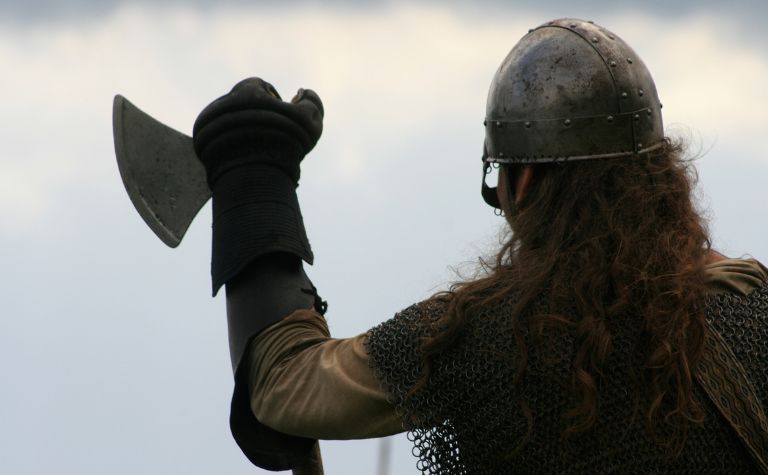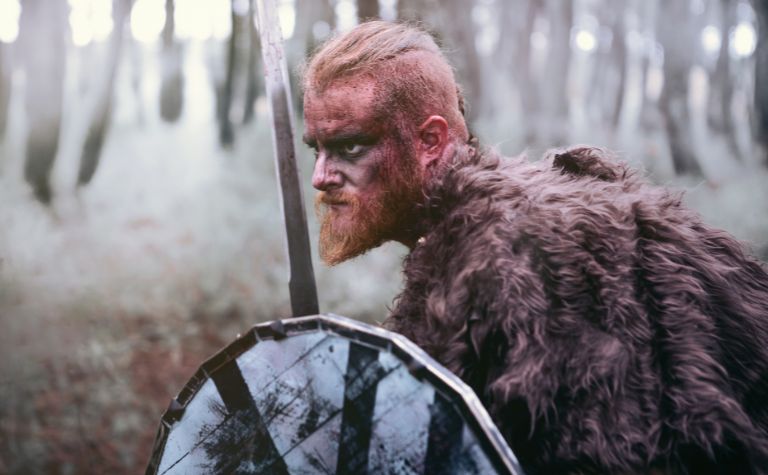Ragnar Lodbrok is one of the most well-known figures from Viking lore. However, much of what is known about him has been sourced from legends, and there is even some dispute about whether such a figure actually existed.
Inevitably, there is much confusion over the events in his life, including questions about his birth and nationality.
Ragnar Lodbrok may have been Swedish or Danish, although definitive information on his ethnicity is lacking. He has been described as the king of Sweden, Denmark, or both countries.
It is also possible that the character Ragnar Ladbrok does not correspond to an actual historical figure.
This article will list the sources of information about the life of Ragnar Lodbrok and cover other figures associated with him who have come to be equally well-known over the years, including his wives and sons.

What Records Exist of Ragnar Lodbrok?
Records of Ragnar Lodbrok’s existence include the following literary and historical sources:
- Icelandic sagas and poems
- The Gesta Danorum
- The Anglo-Saxon Chronicle
The Icelandic Sagas and Poems
The Icelandic sagas tell stories from before the colonization of Iceland in the late 8th century A.D.
Like legends everywhere, they are prone to flights of fancy, making it hard to ascertain the historical accuracy of many of the details mentioned.
Notably, the sagas were initially transmitted orally before being transcribed generations later.
This makes it likely that information was modified or lost before the written versions were finally recorded, and it is harder to verify the authenticity of much of the information included in them.
Several of the sagas mention Ragnar Lodbrok and describe his exploits as well as those of his extended family.
Most prominent among these sources are The Saga of Ragnar Lodbrok and The Tale of Ragnar’s Sons.
Ragnar Lodbrok is also mentioned in many Old Norse poems, known as skaldic poems, most notably the Ragnarsdrápa and the Krákumál.
The Saga of Ragnar Lodbrok
The primary source of information on Ragnar Lodbrok is The Saga of Ragnar Lodbrok.
Consistent with the genre of the Icelandic saga, it recounts Ragnar’s heroic deeds and establishes him as the founder of a great Norse family.
According to the saga, Ragnar, son of King Sigurd Hring, is a handsome warrior whose exploits include the slaying of dragons. It also narrates his courtship of his three wives:
- Thora
- Aslaug
- Lagertha [1]
The Saga of Ragnar Lodbrok culminates with Ragnar’s foolish attempt to take England with only a pair of ships.
He is caught and tossed into a deep pit of snakes by the Northumbrian king, King Ælla. That is how Ragnar finally meets his end.
After his death, Ragnar Lodbrok’s sons avenge him. These sons include:
- Bjorn Ironside
- Rognvald
- Ivar the Boneless
- Hvitserk
- Sigurd Snake-in-the-Eye
Together, they invaded England with a large fleet of Viking vessels and tortured and killed King Ælla.
The Tale of Ragnar’s Sons
Another Icelandic saga, The Tale of Ragnar’s Sons, tells of the exploits of Ragnar’s sons.
It suggests that the kingdom Ragnar inherits from his father spans parts of both Denmark and Sweden.
Besides Ragnar’s sons by his second wife, Aslaug – Sigurd, Bjorn, Ivar, and Hvitserk – it also mentions Eirek and Agnar–his sons by his first wife, Thora.
The Tale of Ragnar’s Sons describes Ragnar as a just ruler and traces the lineage of later Danish and Norwegian royal families to him.
Other Sagas and Poems
Ragnar Lodbrok is also mentioned in several of the other Icelandic sagas, including the Hervarar Saga, the Sögubrot, and the most famous of the sagas, the Heimskringla.
He also appears in the 12th and 13th-century skaldic poems, Ragnarsdrápa and Krákumál. [2]
The Krákumál links Ragnar to the earlier Teutonic heroes and famous dragon-slayers, Siegfried and Brunhild, via marriage.
The Anglo-Saxon Chronicle
This 9th-century English text is considered a more reliable source on Ragnar Lodbrok.
It chronicles the invasion of East Anglia that Ragnar’s sons launched in 865 A.D. and confirms the story of the sons avenging their father’s death by killing King Ælla, the king who ordered his death. [3]
The Gesta Danorum
The Gesta Danorum is a 12th-century historical text by the Danish author Saxo Grammaticus, although it also includes legends.
It recounts how Ragnar led a military campaign against the Holy Roman Emperor Charlemagne and reiterates the story of his death in the snake pit.

Did Vikings Come from Sweden?
Vikings came from Sweden, as well as from Denmark and Norway. There are also mentions of Finnish, Estonian, and Saami Vikings in the historical record, although these are rarer. [4]
Vikings came from the Norse people who had their homelands in the Scandinavian countries.
Prominent mentions of Vikings in the historical record occur mainly between the 8th and 11th centuries A.D.
Although concentrated in the far-northern regions of Western Europe, they were distinguished mainly by their pagan culture, in opposition to Christian Europe, rather than by nationality.
As Norse tradition was primarily oral, the Vikings only appeared in the historical record when they came into contact with other Europeans.
The earliest instances of these were attacks on the English and French coasts in the 9th century A.D.
After the 12th century, the Vikings settled down in various places in Europe and assimilated with the local populations.
Eventually, they became indistinguishable as a separate population.

Who Was Ragnar Lodbrok’s Family?
Ragnar Ladbrok was the son of King Sigurd Hring. His three wives were Thora, Aslaug, and Lagertha.
He is also said to have had as many as twelve sons, including Bjorn Ironside, Ivar the Boneless, Hvitserk, Sigurd Snake-in-the-Eye, Rognvald, Eirek, Agnar, Halfdan, and Ubbe.
It is a matter of historical debate whether Ragnar Ladbrok actually existed, and much of the information available on him is derived from fantastic and sometimes contradictory legends.
These same sources also contain substantial information on his family.
Interestingly, the characterization of Ragnar’s sons, who led the Viking invasion of England in the 9th century A.D., is more likely to be based on actual historical figures than the character of Ragnar Lodbrok which emerges from the same legends.
Conclusion
Ragnar Lodbrok was likely Swedish or Danish, if he existed at all, which is a matter of some dispute.
